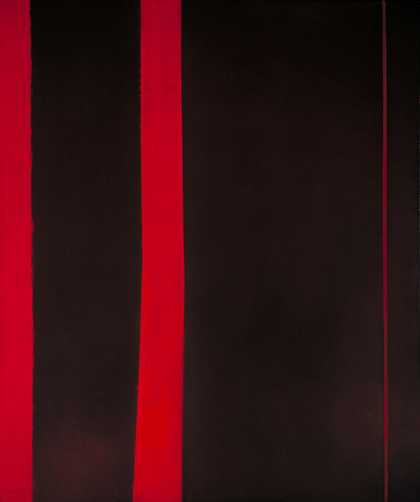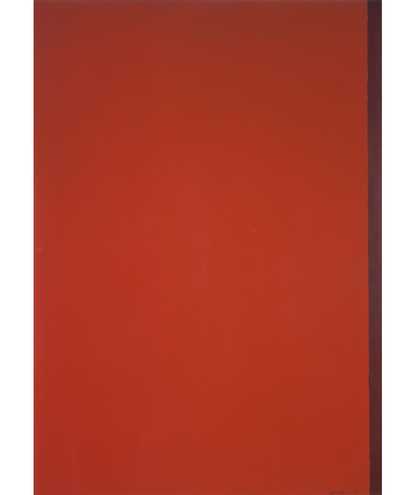The title of Barnett Newman’s painting Adam 1951, 1952 (Tate T01091; fig.1) aligns it with a cluster of other pictures by the artist that reference the biblical account of humankind’s beginnings: Eve 1950 (Tate T03081; fig.2), Genesis: The Break 1946 (private collection), The Beginning 1946 (Art Institute of Chicago, Chicago) and Genetic Moment 1947 (Fondation Beyeler, Riehen and Basel). Moreover, in Newman’s writings, ‘the first man’ and his experience of the world, envisioned biblically and anthropologically, are key themes. As such, one way to approach interpretation of Adam is to explore the significance of beginnings – old ones and new – for Newman and for some of his abstract expressionist colleagues.
Starting from scratch
Looking back in 1967 on the occasion of a symposium in honour of Jackson Pollock’s first major museum retrospective, held at the Museum of Modern Art, New York, Newman recalled that in 1940 he and other artists felt the need to ‘start from scratch’. ‘In 1940, some of us woke up to find ourselves without hope – to find that painting did not really exist … or … was dead. The awakening had the exaltation of a revolution. It was that awakening that inspired the aspiration … to start from scratch, to paint as if painting never existed before.’1 The reasons for feeling this way in 1940 did not need to be spelled out then, nor do they now. The cataclysms and traumas of recent history were intensely present. In 1939, as a new world war was beginning, artist and critic Nicholas Calas had wondered ‘how will painting continue and at the same time express the tragedy of our days?’2 For Newman and some of his contemporaries, moving forwards in a time of trauma demanded a move backwards. Starting anew required returning to primal scenes of art and even of all creation in order to recover and work through formative episodes. This psychoanalytic model of temporality permeated their thinking about artistic recovery.
For Newman, starting from scratch was not a matter of making a break in a linear timeline of art and beginning with a tabula rasa. It meant rather turning that timeline back on itself, circling back to beginnings, originary moments, in the history of art and of creation. His words ‘as if painting never existed’ did not mean ‘as if art had never existed’. Before ‘painting’, for Newman, stood a whole string of artistic beginnings, represented by so-called ‘primitive’ and ‘archaic’ arts – pre-Columbian stone sculpture, Oceanic masks, Native American burial mounds, Northwest Coast Indian art – some of them painted, some quite abstract, all of which he studied, wrote about and admired. He seems not to have wanted or needed to imagine making art as if these precursors had never existed. His identification with them was too strong.
Construing such works as ‘beginnings’ calls attention to teleological and ideological aspects of that term. Any beginning appears as such because of some ending towards which it is understood to be a first step. The allegedly ‘primitive’ artefacts Newman admired represented advanced stages in artistic traditions that had begun long before. Newman was merely returning to earlier stages in art’s history, not the actual beginnings he took them to be. He was starting not ‘from scratch’ but from far along the line.
Like several of his colleagues in the New York School of avant-garde artists, Newman identified with the figure he imagined to be responsible for such artefacts: ‘primitive man’, even the very first human, yelling in ‘awe and anger at his tragic state, at his own self-awareness and at his own helplessness before the void’.3 There was no question that he saw himself reliving the primal experience he envisioned. ‘What was the first man, was he a hunter, a toolmaker, a farmer, a worker, a priest, or a politician? Undoubtedly, the first man was an artist.’ Newman’s point was that ‘the aesthetic act always precedes the social one’.4 For him and the New York School, modern man was like primitive man in feeling terror in the face of overwhelming, uncontrollable forces, and the necessity for effective artistic expressions of distinctly modern terror and tragedy superceded all other pursuits.
Origins and ‘breakthroughs’
This first man, as Newman envisioned him, was both a primeval worshipper of a totemic ‘tiger-ancestor’ and the biblical Adam. Newman believed that the author of the book of Genesis had portrayed Adam allegorically as an artist: his eating fruit from the tree of knowledge was the mark of his desire to seek ‘the creative life to be, like God, “a creator of worlds”’.5 Newman identified with both Adam and God in the brotherhood of creators of worlds.
Newman’s words often deliberately mixed biblical history with imaginative anthropology, and this combination points to something important about Newman’s habits of thought: his interest was in beginnings of every kind rather than in any consistent history. Contradictions between archaeology, anthropology and religion were unimportant; all earlier moments construed as creative beginnings in whatever field of study could be merged. No matter that the first man who emerged from such incompatible accounts had both the hubris to emulate God and the anxiety to quiver before the cosmos and the fates. The conflict enabled Newman to envision Adam in his own image. In this sense, his painting Adam is a self-portrait, with conflict at its core.
Beginning and reflecting on beginnings were things Newman seems to have done instinctively. He was always turning the timeline back on itself; never allowing it to simply continue ahead. In fact, continuing, simply moving forwards, was a mark of weakness and failure in his view. He disparaged surrealism as ‘a continuous performance’.6 By contrast, he himself always began anew. He said in 1962, ‘I start each painting as if I had never painted before … The fact is, I am an intuitive painter, a direct painter. I have never worked from sketches, never planned a painting, never “thought out” a painting.’7 There is irony in the fact that an artistic oeuvre of such consistency – so much of Newman’s mature work is structured as coloured fields punctuated by vertical bands – emanated from a programme of constantly beginning anew. The charge made by some critics that his work was repetitious may have prompted him to emphasise his commitment to always starting from scratch.8
Within the endless panorama of beginnings that his work represented, Newman spotlighted certain moments as especially radical beginnings. One came in 1944–5, when, by his own assessment, his artistic maturity began. All the art he had made prior to that year he destroyed.9 That is, he destroyed his own artistic beginnings in order to claim later stages of his work as starting points.
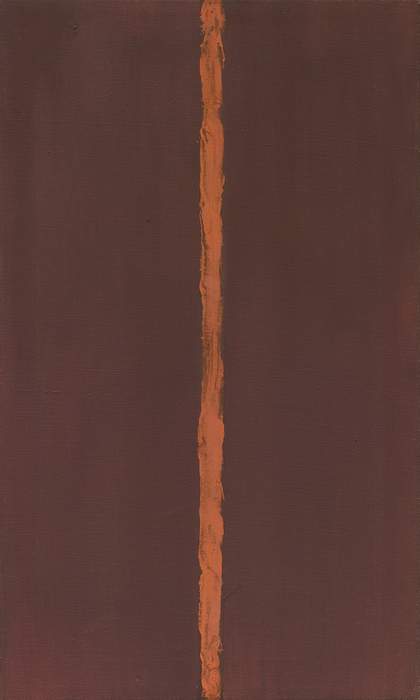
Fig.3
Barnett Newman
Onement I 1948
Museum of Modern Art, New York
© 2018 Barnett Newman Foundation/Artists Rights Society (ARS), New York
Another such moment came in 1948, with the painting Onement I (fig.3), the making of which he later mythologised as the decisive breakthrough of his artistic career. This painting, he said, had struck him like a bolt of lightning. It seemed to have a life of its own, and he dated its completion to his own birthday, 29 January, perhaps using some poetic licence:
I recall my first painting – that is, where I felt that I had moved into an area for myself that was completely me – I painted on my birthday in 1948 … when I painted this painting, which I call Onement, my first Onement, so to speak, I stayed with that painting about eight, nine months, wondering to myself what I had done.10
Beginnings were Newman’s speciality, so it is no surprise that he was attentive to representing his own artistic beginnings. In 1958 and 1959, when he was invited by E.C. Goossen and Clement Greenberg to hold solo exhibitions of his work (his second and third solos, the first having been held back in 1951), Newman chose to include only paintings made between 1946 and 1952, as the title of one of the shows indicated.11 This was noted in nearly every review of the exhibition.12 If we did not understand Newman’s obsession with beginnings, we might take this highlighting of earlier works as marking a lack of confidence in his paintings of the intervening six or seven years. To some extent he really had lost momentum; his productivity had declined dramatically since 1955. But we should also see this decision as fulfilling a desire to return to an earlier stage of his art that he wished to frame as his beginning. As Newman said at that time in response to his critics: ‘They say I have advanced abstract painting to its extreme, when it is obvious to me that I have made only a new beginning.’13 Evidently, he prized beginning over advancement, even when the latter term was not intended as a criticism.
The temporality of production in Newman’s work
Do we find in the forms of Newman’s paintings an equivalent commitment to beginnings? What kinds of temporality do they suggest? When we speak of the temporality of a painting, we may mean the time involved in its production as this is signalled in the visible record of its making. Or we may mean the way that time is experienced by a viewer standing before the work. Both kinds of temporality are noteworthy in Newman’s art.14 As the artist himself wrote in 1949: ‘The concern with space bores me. I insist on my experiences of sensations in time – not the sense of time but the physical sensation of time.’15
Let us turn first to the temporality of production. Although he said he started each painting as if he had never painted before, Newman always began his paintings in the same way. He attached masking tape to a primed surface and then applied a pervasive colour, or he covered the whole surface with a colour before applying the tape. This description of his process comes from Carol Mancusi-Ungaro, the conservator who has analysed the materials of Newman’s paintings the most thoroughly. As she puts it: ‘Newman would choose one or the other method of beginning a painting from the earliest works to the last.’16
The process of getting the masking tape’s edges positioned where he wanted them and keeping them straight must have taken some time and effort, especially with larger paintings. Newman sometimes did not seal the edge of the tape but left it floating slightly, which permitted some paint to seep underneath. Seeping paint leaves a visible record of the layers of labour: first blocking out the central line with a strip of tape, and subsequently protecting the edges between the line and the larger field of colour with strips of tape on either side while the line is filled in. Time invested in preparation of the taped canvas enabled faster application of paint. A clean, straight edge could be achieved relatively quickly once the tape was in place. Actual painting time was compressed by virtue of extended – and concealed – preparation time, and in cases where the band was repainted several times, there were multiple preparations that might or might not be visible.
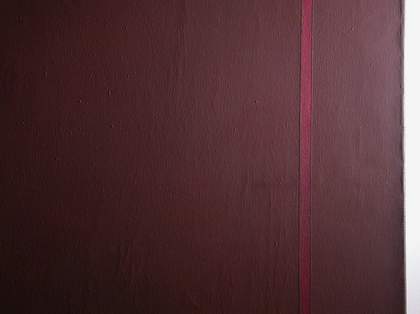
Fig.4
Barnett Newman
Adam, detail photographed in raking light
Photo © Tate
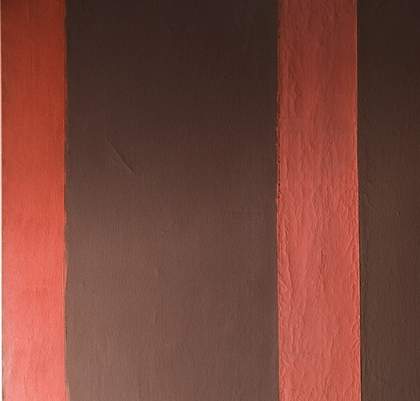
Fig.5
Barnett Newman
Adam, detail photographed in raking light
Photo © Tate
Adam has distinct ridges marking parts of its bands – especially the narrow one in the right of the composition (fig.4). Inside that band, the texture of the canvas ground is more evident, indicating fewer layers of paint (and an earlier application of tape). The raised ridge that separates this band from the adjacent deeper reddish-brown field suggests multiple phases of work with tape on both sides of the ridges. In what appears to have been the final phase of work, dark reddish-brown paint from the wider field of colour was allowed to cover the ridge and seep slightly onto the brighter red of the band. Parts of the wider bands at the left also display ridges, and here both of the reds spread over the ridges at different points (fig.5). The separation of the wider bands from the expanse of deep reddish-brown is more laboured and less sharply defined.
Newman’s broad colour fields are also complex in terms of their production time. He often emphasised that these apparently flat fields were not quickly or easily realised. Although he sometimes worked with a spray gun and industrial rollers, the fields usually involved complex colour mixes and brushwork. Newman said: ‘The impression that I think people have is that the easiest thing in the world is to lay down a flat area of paint. Actually, it happens to be the most difficult thing to do.’17 On another occasion he said, ‘the large open areas I use require, as the restorers of my work are beginning to realize, the highest artistry’.18 Mancusi-Ungaro agrees, stating that his colour fields are ‘created with sophistication, complexity, and nuance’.19 They are often full of brushwork but seem anti-brushwork. Newman, she says, ‘used multiple and complex layers of paint to create color’.20 In later works he often mixed media and application tools to achieve his colour fields. Another laborious, invisible effort required for those large flat fields was the painstaking removal of tiny brush hairs from the paint with a pair of tweezers. Thirty-three pairs of paint-stained tweezers were found in Newman’s studio upon his death.21
Band and field converge in this point: the visible effort, the actual painting, represents a small fraction of the time involved in producing the work. The look of quick execution is bought at the price of an extended labour that is only partially apparent.
The use of masking tape also introduces other complications into the production time. Normally the sequence of actions that have produced a painting can be roughly reconstructed from the layers of paint that constitute the surface like geological strata. Masking tape, when painted over and then removed, exposes an underlying layer by extracting a slice from the topmost layer. In addition to disrupting the temporal sequence of production, and exposing it to view, this process allows the artist to return to an earlier stage of the painting and, on that part of the canvas, begin again.
Newman had worked with masking tape before Onement I, but his earlier colour fields were highly modulated. One of the innovations introduced in Onement I was the relatively uniform field. Another was the fact that the masking tape was left on the surface. The painting is one of two completed works with masking tape still in place.22 The tape provides a subtle, darker, regular band underneath the bright, irregular, brushy band painted on it. Newman was likely testing this colour and its brushy handling, and the tape ensured easy removal. But the survival of the tape indicates a change of plans.23
Although it is a relatively subtle visual presence, the tape is an important sign of the possibility of returning to an earlier stage in the painting process. The most autographic, expressive element in Onement I is painted on top of the tape, which puts its survival into question. Its future once hung in a delicate balance, as the artist weighed a choice. Which was greater: the urge to begin again, to give oneself a second chance, to return to an earlier stage in the painting process and invent a new, partial beginning; or the desire to preserve the fresh and dynamic latest addition to the picture, which was also its most expressive and spontaneous component? Contingency and fragility were powerfully encoded in this combination of formal elements. The choice Newman made – to leave the tape in place – effectively transferred the choice to viewers, not as a real possibility, of course, but as a hypothetical one. By making one of its layers imaginably removable, thereby investing a decisive and forceful composition with uncertainty, Onement I enfolded questions of contingency and time. The opportunity to circle back to an earlier stage of painting may not have been taken by the painter in this case, but he wanted the option, and the evidence of this desire remains visible. The temporal sequence involved in producing the easily distinguished layers of Onement I is vividly clear, but its contingency is forcefully affirmed.
In Adam Newman made the decision to pull the tape. By this time, in 1951–2, thanks to the example of Onement I and Concord, the possibility of leaving the tape in place as a compositional element was present from the moment of its application. The status of the tape in Newman’s work had changed – from invisible, instrumental tool on a par with a paintbrush to possible collage material. Leaving the tape on would have to be done rarely, however, if it were to convey effectively the sense that a special occurrence had warranted a departure from ordinary procedures.
We can see that the time of production is convoluted in Newman’s paintings. Things that appear quickly done are often labour- and time-intensive. Things that are actually quickly done are enabled by long preparation. The signalling of production time through paint layering is made a matter of complex reflection, involving circlings back, fragile contingencies and surface rifts fully or partially repaired. Newman’s own comments on the duration of his process highlight its paradoxical temporality. ‘I was asked by a viewer how long it took me to paint Vir Heroicus Sublimis [1950, 1951 (Museum of Modern Art, New York)]. I explained that it took a second but the second took a lifetime.’24 By expanding preparation time to encompass all of his life experiences he raised the temporal compression to its maximum.
Viewing Newman in time and space
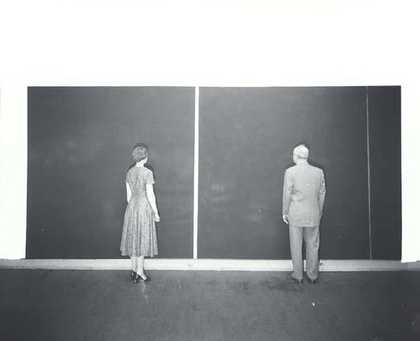
Fig.6
Peter A. Juley
Barnett Newman and an unidentified woman standing in front of Cathedra in Newman’s Front Street studio, New York, 1958
Peter A. Juley and Son Collection, Smithsonian American Art Museum, Washington, D.C., J0112534
What about the temporality of viewing Newman’s paintings? Their relatively simple, abstract structures present viewers with a totality that can be perceived and described almost immediately. Newman himself described this effect of his work: ‘At one instant one gets the whole painting … there is nothing to really examine.’25 But at the same time, Newman encouraged viewers to stand close to his paintings, not necessarily to examine the surfaces but to immerse themselves in the spaces of his often expansive colour fields. A famous photograph from 1958 shows Newman himself standing close to his painting Cathedra 1951 (Stedelijk Museum, Amsterdam), exhibiting the proper mode of address towards his works (fig.6).
Newman frequently expressed the belief that this close address gave viewers an experience of the paintings as if from inside, so to speak; and this, he thought, would carry a strong sense of temporal immediacy. The vivid experience of being inside a special place is precisely the kind of on-the-spot absorption in the present moment that Newman had experienced at the massive Native American burial mounds in Ohio, which he visited in 1949. As he wrote on that occasion, ‘The greatest, most profound feelings of the human spirit never arise inside a frame of space. They always arise around the concept of time.’26 Art historian Richard Shiff has explained this statement by contrasting the framing of space, which makes viewers conscious of being outside a painting and looking in, with the vivid sense of present time that comes from being inside an intense experience.27 In Shiff’s words, Newman’s was ‘an art of time and place, an experiential art that would be lived by each person who encountered it’.28 Shiff goes on to argue that this experiential time marked a decisive break in post-war art. ‘By 1945 Newman had realized the need for a new artistic use of experiential time as a way of acknowledging the cataclysmic break, the postwar shift from terror to tragedy.’29
But standing close to the painting as Newman prescribed would also bring awareness of the subtleties of layering, edges and complex fields that I have been describing. Newman certainly wanted such subtleties to be noticed, or he would not have left evidence of the process, including bleeding, which sometimes exposes multiple layers of underlying colour. In light of these clues, a different sense of time overtakes the presentness of the experience, as the viewer unfolds the complex time of the painting. A viewer who chooses to emulate Newman’s own example of contemplation before Onement I (even if not for a full eight months), by following Newman’s protocols and standing close to the surface, would likely be provoked to circle back to earlier stages of the painting construed as beginnings.
Conflicted surfaces
Even without paying close attention to surface details, Newman’s characteristic compositional format of fields of colour divided by vertical bands evokes the idea of beginnings, as philosopher and literary theorist Jean-François Lyotard implies in a comment on Newman’s titles. ‘The titles of many of his paintings suggest that they should be interpreted in terms of a (paradoxical) idea of beginning. Like a flash of lightning in the darkness or a line on an empty surface, the Word separates, divides, institutes a difference, makes tangible because of that difference, minimal though it may be, and therefore inaugurates, a sensible world.’30
With Adam, when a viewer steps back to take account of the full effect of the composition, an unusual irregularity becomes apparent. Most often, Newman’s painted bands follow straight lines. In Adam, however, the band near the centre widens slightly in its bottom half, diverging from the vertical by 4 or 5 degrees to the left. This bent band may be unusual in Newman’s work, but the conflict it introduces into the painting – between regularity and irregularity, structure and disruption, or order and disorder – is not. The bold assertiveness of the two wide, bright red bands, in proximity to one another, is undermined by the drift of one towards the other. The deviation causes the painting’s hard geometry to tremble.
Newman’s paintings employ various devices to produce conflicts of this sort, and this aspect of his work is something he shares with his colleagues of the New York School.31 For many of these artists, conflict inside and outside the individual – between conscious control and spontaneous impulse, or between forceful action and expressions of impotence before the power of fate and history – characterised their experience of modern life and their sense of self in the period after the Second World War. Unsurprisingly, it also permeates their painting and their thinking and writing about art.
The conflicts and paradoxes that have emerged in the present discussion of Newman’s attitudes towards beginnings and time belong to this thematic framework. His paintings have a conflicted relationship to history. As noted earlier, Newman’s appetite for beginnings of every sort overshadowed any interest he had in a consistent history. Undoubtedly his attraction to beginnings had an historical motivation. Newman’s writings explicitly linked desperation, hopelessness and the irresistible impulse to ‘express’ terror and tragedy to experiences of historical trauma.
But Newman’s project is also fiercely anti-historical. It seeks escape from history by returning to imaginary prehistoric, presocial moments, when artists emulated the divine creator, of whom they had direct knowledge, and when the sole concern of their aesthetic creation was expression of the timeless, terrifying and tragic human condition. Perpetual philosophical problems, emanating from a universal human condition, are the frame of reference for his art and thought, and this deprives history of any significant change. Historical time is structured by constant repetition and eternal returns. The changing complex of political, social and economic relations that constitutes human history drops out of consideration. Whether this material history is envisioned as linear or cyclical or something else, Newman and his art seem to stand outside of it.
The fantasy of being outside history is evident in Newman’s frequent revising of his earlier work. The paintings he designated as marking his own artistic beginnings could be taken up and reworked at any time. Adam’s completion was evidently as complex as the beginnings it evokes. When the painting was first exhibited, at Betty Parsons Gallery in New York in 1951, it contained only two vertical bands: the ones at left and right. The central, skewed band was reportedly added a year or so later.32 The colour of the narrow band on the right may have also been changed at some point. A black and white photograph taken at an undetermined date shows the painting with three bands, but with the narrow right-hand band painted in a much darker tone than the surrounding ground.33
In a 1969 essay strongly shaped by Newman’s own comments, critic Barbara Reise articulated the idea of Newman’s art escaping time:
In the early fifties he [Newman] had a wealth of unsold work to live with, modify and improve, and instigate further explorations. Vir Heroicus Sublimis and Adam received additional stripes which improved their essential characters; more than ten years later the addition of a lateral edge band changed Resurrection so distinctly that it was re-titled Be II [1961, 1964 (National Gallery of Art, Washington, D.C.)]. These historical additions are not immediately apparent or intrinsically relevant in any of these paintings now. Just this fact points to Newman’s peculiar ability to stand outside even his own history to re-enter it through his particular sense of timeless time.34
One can hear Newman’s own voice echoing in that notion of timeless time – a time whose circles, loops and discontinuities are as tangled as his paintings are rectilinear. It is also a time that renders history an endless and unvarying sequence of new beginnings.

